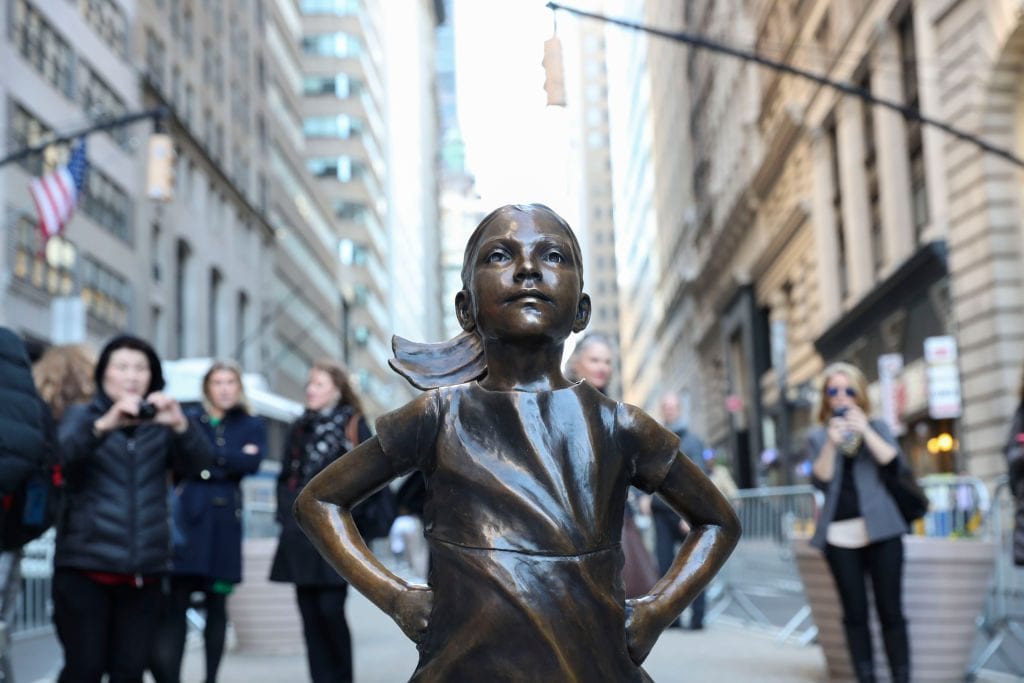Last month, Dallas-based Copart Inc, a company that provides online vehicle auction and re-marketing services, appointed Diane Morefield to join its board. The company’s revenue topped $1.5 billion dollars last year and has more than 6,000 employees across 200 locations across the world.
That means all 500 of America’s largest publicly listed companies finally have a woman on their boards.
What might have pushed them and others to such action? It seems advocacy may have helped, including with the very public help of the now famous Fearless Girl statue, along with some US states changing its laws on the matter. In 2018, California passed a law requiring publicly traded companies to have at least one woman on their boards by the end of 2020. By the end of July 2021, boards with five members are required to have at least two women to their boards and boards with six or more members must have at least three women.
Norway, Spain, France and Iceland are pushing even further. These countries all have laws requiring that women comprise at least 40% of boards at publicly listed companies.
Here in Australia? The news isn’t very cheery. Last month, we reported that the Australian Institute of Company Director’s aim of reaching 30% women on boards by the end of 2018 had failed.
Four companies on the ASX200 (Australian Securities Exchange) remain without a single woman on their boards. As of June this year, the all-male boards included HUB24 Limited, mining contractor NRW Holdings Limited, mining group Emeco Holdings Limited and telecommunications and IT company TPG Telecom Limited.
As the S&P experience shows, getting those final boards to appoint a woman can take a long time, with Bloomberg reporting around 86 per cent of S&P 500 companies had at least one woman on their boards in the year 2000 — and the last 14% taking almost 20 to bridge the divide.
The Perth-based mining company NRW has around 2300 employees and a revenue of $1.1 billion in the 2019 financial year. Emeco Holdings share price fell almost 45% during the last financial year, putting them in the top 10 worst ASX200 performers in the 2018/2019 financial year. TPG recently saw total revenue slip 1.7% year-on-year and its proposed $15 billion merger with Vodafone was rejected by the Australian Competition & Consumer Commission (ACCC) in May.
Some companies are making great strides in gender equality on boards. Back in May, Future Super became the first super fund to completely exclude investments in companies that have no women on their boards.
So, what’s keeping more women from obtaining Board seats? According to the Wall Street Journal’s Vanessa Fuhrmans, it’s the fact that board seats rarely become available. The average member stays more than a decade, creating few openings. So, there’s little turnover. Furthermore, while companies are appointing more women to board seats at increasing rates, the overall share of female directors remains unchanged.
https://www.instagram.com/p/BxuafWrHoaD/
Dismally, even some newer companies are failing to achieve balance.
WeWork, the popular shared spaces company for entrepreneurs, freelancers, startups, small businesses and large enterprises, last week released their Initial Public Offering (IPO) which revealed two interesting facts: firstly, they made a loss US$1.6 billion last year and secondly, everyone on their board is a man.
As we’ve reported here at Women’s Agenda, research shows that companies with strong diversity have better competitive performance, talent management and risk mitigation. Women having a strong voice in the boardroom consistently translates to better financial performance.


